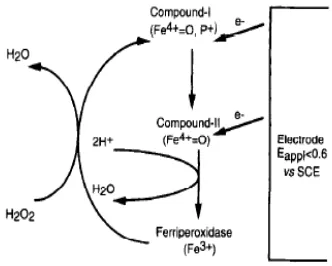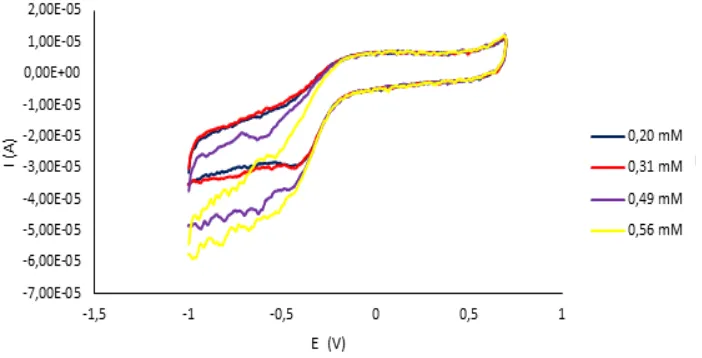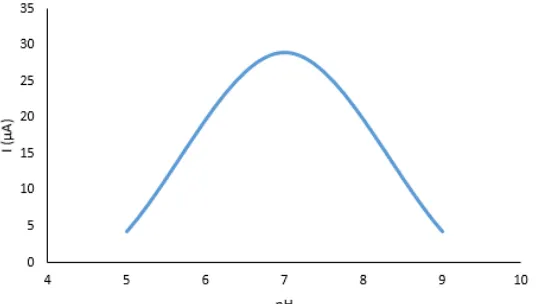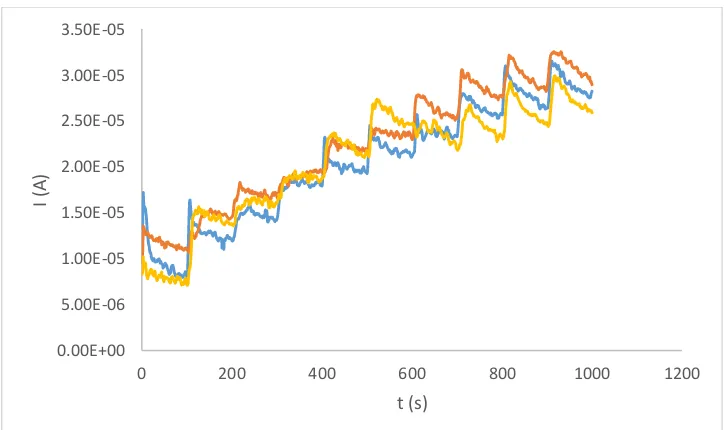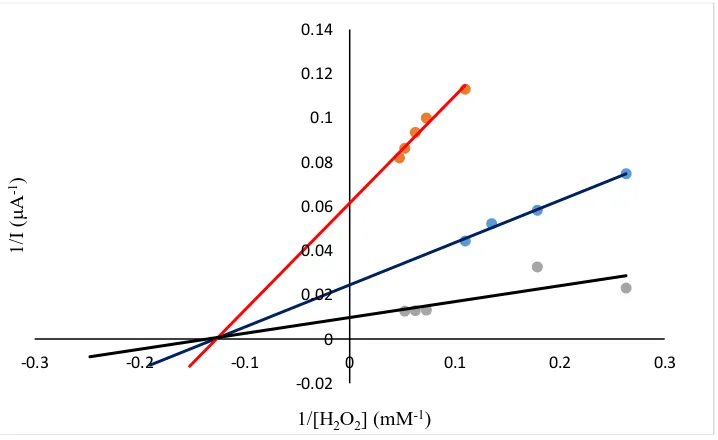Int. J. Electrochem. Sci., 14 (2019) 10130 – 10138, doi: 10.20964/2019.11.23
International Journal of
ELECTROCHEMICAL
SCIENCE
www.electrochemsci.orgThe Effect of ACE Inhibitor (perindopril) on Peroxidase
Activity in vitro Conditions
Safija Herenda1,*, Jelena Ostojić1, Mladen Miloš2, Edhem Hasković3, Denis Hasković4, Ena Deljkić5
1 Department of Chemistry, Faculty of Science, University of Sarajevo, Zmaja od Bosne 33-35, 71 000 Sarajevo, Bosnia and Herzegovina;
2 Faculty of Chemistry and Technology, University of Split, Teslina 10, 21 000 Split, Croatia; 3 Department of Biology, Faculty of Science, University of Sarajevo, Zmaja od Bosne 33-35, 71 000 Sarajevo, Bosnia and Herzegovina;
4 Clinical Center of the University of Sarajevo, Organizational unit Clinical chemistry and biochemistry, Bolnička 25, 71 000 Sarajevo, Bosnia and Herzegovina;
5 Faculty of Pharmacy, University of Sarajevo, Zmaja od Bosne 8, 71 000 Sarajevo, Bosnia and Herzegovina;
*E-mail: islamovic.safija@gmail.com
Received: 9 June 2019 / Accepted: 10 Avgust 2019 / Published: 7 October 2019
Hypertension is one of the leading diseases of today. ACE inhibitors are used in the prevention and treatment of hyperthyroidism, as well as other diseases such as pulmonary hypertension, proteinuria, etc. In this study we examined the effect of ACE inhibitors (Perindopril) on peroxidase enzyme activity in in vitro conditions. By using electrochemical methods we have determined the type of inhibition. We have proven that prindopril has been noncompetitive bonded to the active site on the enzyme, but also on enzyme/substrate complex. From the Lineweaver-Burk diagram, we obtained the values of the maximum value of the current (Imax) and the Michaelis-Menten constant (Km) without presence and in the presence of the perindopril inhibitor. Values of Imax vary depending on the concentration of perindopril, while the Km values are slightly modified, which is confirmed by the theoretical explanation of the noncompetitive type of inhibition. With this work we came to the conclusion that ACE inhibitors can be linked to different sites on oxidoreductase and thus reduce oxidative stress in the organism.
Keywords: peroxidase, enzyme kinetics, perindopril, electrochemical methods
1. INTRODUCTION
[image:2.596.211.377.449.582.2]
inhibiting the reaction of catalysed peroxidase. Immobilization of peroxidase on graphene oxide is a biosensor for the reaction with hydrogen peroxide as an electron acceptor. Also, the immobilization of peroxidase, or its networking in the graphene structure, maintains the catalytic properties, no denaturation of enzymes and no reduction in its activity is observed. For the characterization of HRP, electrochemical methods were used, following the catalytic direct transfer mechanism of the electron described in the work of the author Ostojic et al. Direct electron transfer of immobilized HRP is based on the Fe(III)/Fe(II) reduction in the active heme center of the enzyme. The first reaction involves a two-electron oxidation of the ferriheme prosthetic group of the native peroxidase by H202 and the formation of component I (HRP (Fe+4=O)+), which is actually an intermediate. Compound I contains oxyferryl heme (Fe+4=O) and a porphyrin π cation radical, also is catalytically active and, when receiving one electron from the substrate, converts to Compound II (HRP (Fe+4=O)). In the third step it is formed HRP (Fe-III) wich is the native enzyme, HRP (Fe+4=O)+ and HRP (Fe+4=O) are the oxidized forms of the enzyme and AH2 and AH· are the electron donor substrate and the radical product of its one-electron oxidation [1]. The oxidation products formed during the HRP reaction depend on the nature of the H2O2 [1,2]. When first reaction mechanisam proceeds on an electrode surface compound-I can be reduced into ferriperoxidase by a heterogeneous electron transfer directly from the electrode material as well as by means of redox mediators [3,4]. Other electrodes for the detection of peroxide consists of a layer of peroxidase molecules wich is adsorbed onto the electrode surface. Many immobilization studies of HRP were carried out on graphite electrodes, GC electrodes, platinum or gold electrodes. Electrochemical measurements performed on a potential less than 0.6 V vs. SCE shows the proportionality between reduced current and peroxide concentration.
Figure 1. Mechanism reduction of hydrogen peroxidase
effect of perindopril - ACE inhibitor on peroxidase activity. In pulmonary hypertension the increase in pulmonary artery pressure is a consequence of changes in pulmonary vascular structure and abnormal pulmonary vasoconstriction. Current drug treatment of this disease involves the use of vasodilator drugs that oppose the abnormal vasoconstriction [7, 8]. Perindopril is long-acting ACE inhibitor wich belongs to the family of ACE inhibitors that contain a carboxyl group and is a prodrug for perindoprilat [8].
2. MATERIALS AND METHODS
Materials: Horseradish peroxidase-HRP (250-330 U/mg; Sigma-Aldrich, Buchs, Switzerland); KH2PO4 and Na2HPO4 (Fisher Chemical, Wien, Austria); Hydrogen peroxide (H2O2) p.a. 30% (Sigma-Aldrich, Buchs, Switzerland); Graphene (Sigma-(Sigma-Aldrich, Buchs, Switzerland), Perindopril (Bosnalijek, Bosnia and Herzegovina).
Methods: In this paper, all measurements were performed on the potentiostat/galvanostat PAR 263A instrument, and methods of cyclic voltammetry and chronoamperometry were used. The system consisted of three electrodes, a GC working electrode, saturated Ag/AgCl reference electrode and a Pt counter electrode. After preparing the surface of the GC electrode, HRP immobilization was carried out on a graphene carrier, where a biosensor for the detection of hydrogen peroxide was made, as described in the literature [1]. The method of cyclic volatametry examined the influence of different concentrations of hydrogen peroxide on the activity of the enzyme and the influence of the pH value in the potential range of -1.0 to 0.7 V. Scan rate was of 50 mVs-1. The electrochemical cell consisted of 25 mL phosphate buffer (pH 7) in which different concentrations of the substrate (hydrogen peroxide) were added, 0.19 mM, 0.31 mM, 0.49 mM, 0.56 mM. The pH value of the pH (5, 7, 9) was recorded under the same conditions of the potential, but at a substrate concentration of 0.31 mM. Chronoamperometric measurements were performed with constant mixing at 400 rpm and a constant potential of 0.7 V without and in the presence of different concentrations of perindopril 0,16 mg/ml i 0,24 mg/ml.
3. RESULTS AND DISCUSSION
gradient, the current changes follow the changes in the concentration gradient on the surface of the electrode. In many amperometric enzymatic electrodes, a redox mediator is used to link redox reactions to the active site of an enzyme with a redox reaction on the electrode. For peroxidase, the active enzyme is a reduced form and the oxidized form of the mediator is recycled to the cathode. In the general mechanism, the oxidized form of the enzyme reacting with substrate forms the enzyme-substrate complex ES with further decomposition to obtain the reduced form of the enzyme and the product [19].
In Figure 2, shows the cyclic voltammograms the influence of concentrations substrates of 0.20 mM, 0.31 mM, 0.49 mM, 0.56 mM to the enzyme peroxidase. If we compare the cyclic voltammograms of Figure 2 with the cyclic voltammograms (figures 1) in the paper by Herenda et al. we see that, for the same potential region, the current values are almost the same [11]. The reason is likely that the enzymes in both papers were from the same oxidoreductase group. However, in this study, we see that oxidation potentials are more pronounced due to the presence of ferric ion in the enzyme and that lower concentrations of substrate are required to produce a reaction between HRP and substrate than is the case with superoxide dismutase and hydrogen peroxide.
We see that at various concentrations of hydrogen peroxide on the surface of the electrode an ES complex is created, as shown in diagram 3. There is a linear dependence of the formation of the ES complex, the proper binding of component I of the enzyme with hydrogen peroxide to its reduced form, which depends on the nature of the substrate. The initial interactions between the enzyme and the substrate molecule are noncovalent.
[image:4.596.144.495.435.614.2]
Figure 3. Effect of substrate concentration on enzyme activity
The relationship between pH and enzyme activity depends on the acid-base properties of the enzymes and substrates, especially the type of amino acid residues in the catalytic center. High pH values generally lead to a complete loss of activity for most enzymes. In determining the optimum pH value for an enzyme, the composition of the environment in which the reaction takes place is also very important, and in particular the composition of the buffer mixture used therein.
In this paper, the effect of pH on peroxidase activity was examined by recording a cyclic voltamogram of an immobilized GC electrode immersed in a cell with a phosphate buffer of various pH values of 5, 7 and 9, with the addition of a substrate of 0.31 mM. In Figure 4, we see that for this enzymatic reaction the optimum pH value is 7. For pH 5, the current value was 4.23 μA, for pH 7 28.9 μA, while for pH 9, a current of 4.3 μA was obtained. In research, Bourdillon et al. has shown that the pH of the glucose oxidase and the mediator is an optimum pH 8 [10]. In the examination of the influence of dipotassium trioxohydroxytetrafluorotriborate (K2[B3O3F4OH]) on the enzyme superoxidedismutase it was proved that the optimal value of pH 7 [11]. By examining the inhibitory effect of (K2[B3O3F4OH]) on the enzyme from the oxidoreductase group, catalase, it has been concluded that the optimal pH is 6.2, that is (K2[B3O3F4OH]) affects catalase by altering the state of ionization on the amino acids on the active sites of the enzyme. [12].
[image:5.596.164.435.567.719.2]
An examination of the influence of different scan rates of the GC electrode is shown in Diagram 5. In the diagram we can see that there is a different crude relationship that is regulated by mass transport and the diffusion process from the surface of the electrode and solution. Also, by increasing the speed, there is an increase in cathode and anode currents.
Figure 5. Cyclic voltamogram of GC electrodes at different scanning rates
Amperometric measurements were performed at a constant potential of 0.7 V and a scan rate of 50 mV/s for concentrations of perindopril of 0.16 mg/ml and 0.24 mg/ml. Each addition of concentrations of substrate 0.4 mM, 0.8 mM, 2.3 mM, 3.1 mM and 3.8 mM was at intervals of 100 s. Diagram 6.
Figure 6. Chronoamperogram of an immobilized GC/HRP/Graphene electrode without the presence and with different concentrations of perindopril: (blue line) without inhibitor, (yellow line) 0.16 mg/ml, (orange line) 0.24 mg/ml
0.00E+00 5.00E-06 1.00E-05 1.50E-05 2.00E-05 2.50E-05 3.00E-05 3.50E-05
0 200 400 600 800 1000 1200
I (
A
)
[image:6.596.142.453.174.327.2] [image:6.596.117.480.476.691.2]
From the obtained diagram, it can be seen that with each addition of the substrate an increase in the current occurs, and the reaction can be monitored until the total enrichment of the substrate is saturated. Michaelis-Menten's constant and maximal current are calculated from the Lineweaver diagram and based on the equation [13]:
1/Iss = 1/Imax + Km/Imax 1/C;
Iss is the steady-state current after the addition of substrate, C is the bulk concentration of substrate and Imax is the maximum current measured under saturated substrate solution.
Figure 7. Lineweaver-Burk diagram with different concentrations of perindopril: (black line) without inhibitor, (blue line) 0.16 mg/ml, (red line) 0.24 mg/ml
On Lineweaver-Burke diagram (diagram 7) we see that this is a noncompetitive type of inhibition. This type of inhibition depends on the concentration of the inhibitor relative to the enzyme concentration. According to the obtained results, the Km changes slightly, because the saturation of the active center of the enzyme does not interfere with the binding of inhibitors to the second part of the enzyme molecule. The value of the maximum current without inhibitor is 0.10309 mol/dm3s, while the value is Km 5.32 mM. From a Lineweaver-Burk plot, the calculated Km values were 7.87 and 7.78 mM, relative to concentration of perindopril, and from the same plot value od Imax were 0.01623 and 0.04081 mol/dm3s. Information on the kinetics of the enzyme immobilized on the electrode or the kinetics of the enzyme-mediator gives us a slower step of the mechanism. The value of the Michaelis-Menten constant depends on the diffusion process on the electrode/enzyme membrane/mediator membrane. Many authors have studied the kinetics of various enzymes and mediators/inhibitors using an electrochemical method. Author Vilkanauskyte at all. has described biosensors based on immobilized enzymes and redox mediators on electrophilized films [14]. Monitoring of immobilized enzyme layers on electrode surfaces has been treated by Mell and Malloy [15,16]. In our work we have proven that the value of Km without presence and in the presence of perindopril affects many factors
-0.02 0 0.02 0.04 0.06 0.08 0.1 0.12 0.14
-0.3 -0.2 -0.1 0 0.1 0.2 0.3
1/
I
(μ
A
-1)
[image:7.596.120.479.222.442.2]
such as mass transport of enzyme substrate and redox cosubstrate in the film and in the adjacent solution, local pH in the enzyme film, partition of substrate and redox mediator between the enzyme film and the solution etc. The same factors were also proved by the authors of Gough at all and Bourdillon at all [17,18]. The kinetics of the enzyme/ substrate complex or the enzyme/substrate/complex medium mediator depend on whether the mediator is trapped in the film with an enzyme or is in solution [19]. A complete theoretical treatment of the steady-state diffusion and kinetics in amperometric immobilised enzyme electrodes where the mediator is also entrapped within the film is described in the work of the author Bartlett and Pratt [20]. Spectrophotometric determination of the type of inhibition in the reaction between dipotassium trioxohydroxytetrafluorotriborate and peroxidase enzymes in the presence of two substrates of peroxide and guaiacol, alternately showed that it was a competitive type of inhibition, which was confirmed by the electrochemical method [21]. ACE inhibitors do not fully block angiotensin II production, but in this paper we have proven to be associated with an active site on HRP as well as on the enzyme-substrate complex, and therefore can reduce proteinuria, pulmonary hypertension and many other diseases related to cardiac diseases.
4. CONCLUSION
The ability of organisms to spontaneously develop collateral vessels represents an important response to vascular occlusions and operates to improve perfusion of ischemic tissues. The reaction between the reduced form of the enzyme (HRP) and the oxidized mediator (Perindopril) has been considered as irreversible. The reaction was achieved by diffusion processes and the transfer of electrons from the surface of the electrode and solution. Perindopril has proven to be an noncompetitive inhibitor of peroxidase, which means that in vivo studies can reduce heart and pulmonary hypertension. The values of Michelis-menten's constants speak of the method of binding perindopril to the active site of the enzyme, but also to the enzyme-substrate complex. Electrochemical studies of the effect of ACE inhibitors (Perindopril) on the activity of immobilized HRP in vitro conditions can be the basis for further in vivo research.
ACKNOWLEDGEMENTS
This work was fully supported by the Croatian Science Foundation (Hrvatska Zaklada za Znanost) under project number HRZZ-IP-2014 – 09-6897.
References
1. J. Ostojić, S. Herenda, Z. Bešic, M. Miloš, B. Galic, Molecules, 22 (2017) 1120. 2. H. Dunford, Chem. Biol., 2 (1991) 1.
6. T. Ruzgas, E.Csoregi, J.Emneus, L. Gorton, G. Marko-Varga, Analytica Chimica Acta, 330 (1996) 123.
7. S.P. Gaine, L.J. Rubin, Lancet, 352 (1998) 719.
8. T.K. Jefery, J.C. Wanstall, Brit. J. Pharma., 128 (1999) 1407. 9. I. Ryss, M. Slutskaya, Akad. Nauk. SSSR, 26 (1951) 216.
10.C. Bourdillon, C. Demaille, J. Moiroux, J. M. Saveant, J. Am. Chem. Soc., 115 (1993) 2.
11.S. Herenda, J. Ostojić, E. Hasković, D. Hasković, M. Miloš, B.Galić, Int. J. Electrochem. Sci., 13 (2018) 3279.
12.S. Islamovic, B.Galic, M. Milos, J Enzyme Inhib Med Chem., 29 (2014) 744. 13.J. Li, S.N. Tan, H. Ge, Anal. Chim. Acta, 335 (1996) 137.
14.A. Vilkanauskyte, T. Erichsen, L. Marcinkeviciene, V. Laurinavicius, W. Schuhmann, Biosens. Bioelectr., 17 (2002) 1025.
15.L. D. Mell, J. T. Maloy, Anal. Chem., 47 (1975) 299. 16.L. D. Mell, J. T. Maloy, Anal. Chem., 48 (1976) 1597. 17.D. A. Gough, J. K. Leypoldt, Anal. Chem., 51 (1979) 439.
18.C. Bourdillon, C. Demaille, J. Moiroux, J. M. Saveant, J. Phys. Chem. B., 103 (1999) 8532.
19.P. N. Bartlett, C. S. Toh, E. J. Calvo, V. Flexer, Bioelectrochemistry: Fundamentals, Experimental Techniques and Applications, John Wiley & Sons, (2008) New York.
20.P. N. Bartlett, K.F.E. Pratt, J. Electroanal. Chem., 397 (1995) 61.
21.J. Ostojic, S. Herenda, S. Galijasevic, B. Galic and M. Milos, J. Chem., (2017), 2017:8134350.
